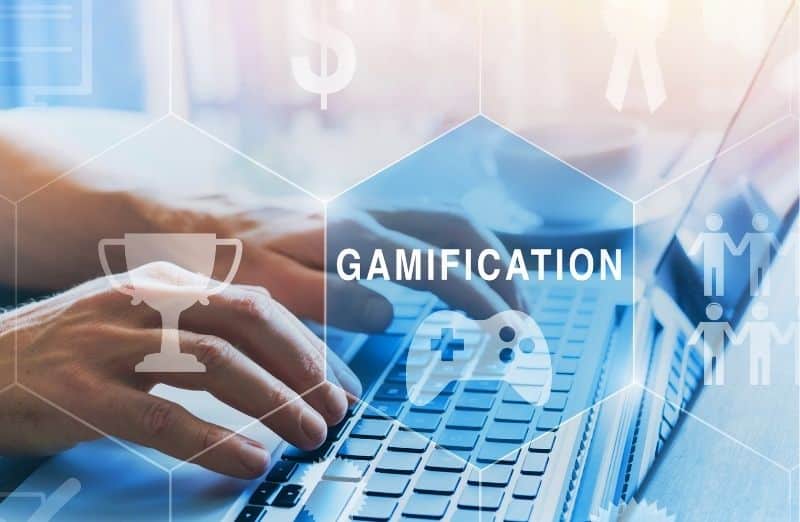If there’s one workplace that has eagerly adopted game mechanics into its workflow, it is surely sales. Gamification in sales (the use of game-like strategies to increase motivation and improve performance afterwards) has always been a part of the sales environment in several ways:
- Leaderboards: A classic of sales gamification, leaderboards encourage competitiveness and self-improvement among sales reps.
- Bonuses and other rewards: These act as powerful incentives within a sales gamification tool, directly linking sales performance to tangible outcomes for sales reps.
- A focus on metrics and KPIs: Tracking key metrics is essential to any successful sales process and fosters a sense of progress for sales teams.
- Departments divided into teams: This structure builds on the innate competitive drive of sales reps, increasing engagement within the sales process.
These strategies, along with classic game mechanics, have long been known to leverage sales reps’ natural ambition and competitiveness. The job of sales targetsis self-selecting; you don’t enter the profession unless you are willing to compete with others and battle to achieve ascendancy within your team or department.
Where a more explicit form of gamification in sales is employed, it often accompanies a dedicated sales gamification software platform. This automates and enables techniques borrowed from games, streamlining the sales process.

Gamification Tools for the Win
Here’s a short list of the kind of additional features gamification in sales and platforms enable:
- Badges and certification
- Levels of achievement
- Points and reward schemes
- Progress bars and personal dashboards
- Gamified training methods
- Social support mechanisms and kudos
- Real-time feedback
- Sales contests
Modern sales environments offer a whole armory of methods for keeping sales reps engaged and optimistic. Morale is vital to any sales office, with high-performing individuals or teams remaining positive, even during challenging economic times.
The Psychology Behind Gamification in Sales
Sales gamification techniques go beyond just fancy tools and leaderboards. They strategically tap into the motivations that drive us all, creating a more engaging and rewarding sales experience. Here’s a breakdown:
- Reward and Recognition: Our brains crave rewards! Sales gamification techniques provide instant gratification through points, badges, or even tangible prizes within sales contests. This reinforces positive behaviors and makes work more fulfilling.
- Progress and Achievement: Seeing progress, like moving up a leaderboard or unlocking a new challenge, motivates sales reps to keep reaching that next level.
- Competition and Collaboration: Healthy competition within sales contests drives individual performance, while gamification also helps team members work together towards shared goals. This fosters camaraderie and strengthens the overall team dynamic.
- Real-time Feedback: Instant feedback on performance offers salespeople the ability to quickly adjust their actions. This continuous learning is essential for improving results, both for individuals and the team.
Explore the Power of Gamification
Sales gamification transforms the often mundane aspects of sales into an engaging and rewarding experience, ultimately leading to higher motivation, sales productivity, and overall business success.
In this piece, we’ll run through 13 sales gamification statistics and other gamification metrics andtrends relevant to the modern workplace. We’ll examine what each statistic reveals and what implication each holds for the modern sales team.
Global Gamification Market Growth: Trends and Projections for Sales
“The global gamification market is expected to demonstrate a CAGR of 12.9% between 2021-2025.”
This statistic demonstrates the widespread uptake of Gamification as an engagement strategy across various applications. Everything from education through marketing to self-improvement apps and retail has benefitted from the techniques of the gamification industry.

What are the game mechanics which have proven so popular and successful? Here are some of the top gamification ideas and tactics found in various use cases:
- HR AND ONBOARDING: Progress bars, personal dashboards, badges, certification.
- SALES AND MARKETING: Leaderboards, bonuses and rewards, kudos, and competition.
- EDUCATION: Progress bars, modular learning, points, quizzes, badges, and certification.
- RETAIL AND ECOMMERCE: Loyalty programs, tiered subscriptions, gamified apps, and products.
- LIFESTYLE AND SELF-IMPROVEMENT: social networks, progress graphs, badges, kudos, rewards.
There’s scarcely an app available for your device in 2023 that doesn’t use some aspect of Gamification. From dating to credit score monitoring to diet and exercise, the tools of Gamification have proved vastly successful in encouraging users to return to the app.
- Between 2016 and 2021, the worldwide gamification industry’s market value nearly tripled, from USD 4.91 billion to USD 11.94 billion.
- According to Gartner Research, Gamification has been adopted by over 70% of businesses belonging to the Global 2000 list of companies.
This increasing prevalence generates a push many sales leaderstoward adoption to maintain a business’s competitive edge. There’s an arms race effect when one company adopts Gamification in its sales team and demonstrates an increase in market share and revenue. This, in turn, will cause rivals to adopt similar strategies.
If Gartner runs a similar survey in five years, this 70% will have increased.
How Gamification Boosts Sales Motivation and Engagement
“According to Talent LMS, 89% of survey respondents prefer to engage in gamified learning tasks.“
Gamification taps into the brain’s reward system, releasing dopamine when tasks are completed. This creates a cycle of positive reinforcement, making work more engaging for sales teams.
Here are some of the common game mechanics which make sales tasks fun:
- Automated notifications of achievement.
- Personal dashboards with graphed progress.
- Kudos messages from colleagues.
- Badges, sounds, emojis, and indicators of success.
All of these are more involving and, therefore, more fun than simply ticking something off a to-do list that you don’t share.
“90% of employees say they feel more motivated at work when a gamification tool is employed.“
Motivation in a sales team can come from different sources, depending on the personality and priorities of the individual rep. For some, monetary rewards are key. For others, the approval of peers is a major component. For the third group, aiming for employee of the month motivates.

One of the best things about Gamification is that it provides a range of options for optimizing employee engagement and motivation, regardless of the individual’s personality. For the three types of motivation described above, for instance, the following game mechanics might work:
- Points can be allocated and exchanged for goods and services or monetary bonuses.
- Social channels enable messaging and sharing of kudos and mutual support.
- Leaderboards allow a rep to monitor their own competitive performance.
Some of the tools of Gamification are explicit (leaderboards, points), and others are more subtle (social reinforcement, gamified training). Still, they all contribute in different ways to making the sales environment more fulfilling and satisfying for individual reps.
“With Gamification, employees experience an average increase in engagement of 48%.“
Game-based strategies keep people engaged for longer or, at the very least, facilitate the changes in activity and short breaks, which rebuild focus. Having a dashboard that records performance, points allocation, and likely bonuses and compares that with other reps is liable to motivate better than everything based on instinct and guesswork.
For some industries (creative, for instance), having KPIs and metrics so dominant might have a demotivating effect. However, in a sales environment, competition is a given, and performance measurement is standard practice. Gamification doesn’t add these components; it merely enhances them.
Gamification imports into a sales environment aspects of mutual support, team building, and self-determination, which make these environments more inviting. This results in lower churn and higher employee retention rates and makes for greater work satisfaction.
“95% of employees report that they enjoy gamified elements at work.“
Aspects of gameplay that are designed to maximize fun include:
- Public celebrations of success (audio or visual indicators of success; the digital equivalent of a gong hit).
- Leaderboard positions can be as flashy or graphic as sales leaders choose.
- Automated badges, points, and bonuses cause dopamine surges.
- Progress indicators and other graphic means show workload completion.
All these mechanics are public demonstrations of success, even in highly distributed or fully remote offices. Modern workplaces are more demonstrative than ever, with fewer “unsung heroes.”
“Employee engagement increases on average by 60% in a gamified environment.“
The improvement that can occur when both sales incentives andgamification solutions are enabled can be dramatic.
When competitiveness increases and employees can more clearly see a direct link between effort and reward, this generates a major motivational boost.
Sales reps are no longer “working in the dark” without knowing their end-of-quarter figures.

Reps can see personalized performance data and predicted outcomes. They can course-correct for any performance shortfalls. Managers to have more free time to concentrate on mentoring and training. Gamified training means that more reps can be upskilled more quickly and reliably.
When nobody falls publicly behind, and firings are therefore minimized, this also boosts morale, building a more secure and hospitable environment.
“85% of employees report spending more time on gamified platforms.“
The addictive nature of games is one of the most powerful tools in a gamified work environment. When reps want to check their daily, weekly, and monthly stats or ascend the leaderboard, this brings them back into daily engagement.
Sales departments get multiple benefits from the addictive qualities of gamified platforms, including:
- Goal and target orientation becomes instilled.
- Performance is constantly notified and frequently rewarded.
- Mutual support builds a feeling of mutual responsibility.
- Friendly rivalries flourish, as everyone competes for “high scores.”
- Fun is maximized, rewarding hard work.
Gamification becomes a self-perpetuating force when it works, driving reps back to their prospecting and sales closures. It stops being a novelty or a tool and becomes a culture.
Game Mechanics and Global Gamification Sales Revenue
“According to the Aberdeen Group, companies using game mechanics experienced an average annual net gain of 4.1% in revenue.“
One little-discussed aspect of gameplay that can help generate revenue is rules adherence. All games have rules which must be followed and strategies that work better than others.
Gamified sales platforms allow reps to try different strategies and then see, in detail, how effective these methods are. There’s never any doubt about whether a rep is doing well; it’s all graphed out for each employee to read on their dashboard.
Managers, too, can also point at the metrics and KPIs that are either being achieved or not. Shortfalls in performance can more easily be tied back to what a rep has been doing.
By having a huge volume of metrics and KPIs at their fingertips, managers can diagnose where any problems lie and intervene.
Data-driven strategy is far likelier to succeed than gut instinct, it appears.
“Fully engaged customers generate 37% more annual revenue in retail banking than disengaged customers.“
Engagement extends from reps to customers. When platforms enable customers to check their own performance (at saving or maintaining good financial hygiene), they become more engaged. It becomes a routine to check balances daily and take steps to avert any cashflow problems.

Many apps are now leveraging gamification techniques to encourage sensible financial behavior, maximize savings, or improve credit ratings. Whereas once, monthly paper statements were the only regular indicators of fiscal health; it has become possible to check balances anywhere, at any time.
Sales are about building relationships
Gamification leads to stronger relationships between brand and consumer, as well as highlighting the causal relationship between consumer action and outcome.
To put it simply, customers learn that “if I do this, then this will happen,” and positive reinforcement takes over, causing them to seek out the reward of a healthy balance.
Once on a bank’s gamified savings or investment platform, habit breeds loyalty, and fewer customers jump ship to other banks.
“A fully engaged customer is equivalent to a 23% premium in profitability, contrasted with actively disengaged customers, who represent a 13% drop.“
As well as building brand loyalty, gamification strategies automate many processes that would otherwise require a lot of time for human workers to achieve. This results in cost savings and greater profitability.
Metrics and data at scale allow marketers to reach more likely customers and sales teams can convert more of them because they have been pre-validated by automated marketing processes already, such as the “check your eligibility” tools that credit card companies and loan providers use.
These tools act almost as miniature games. A credit score health dial resembles the scoring mechanism of a game; why wouldn’t customers want to achieve a better score.
Sales Gamification Statistics: What They Reveal About Performance
Gamification in sales is a powerful strategy to motivate your sales team and increase engagement. By tapping into human psychology, in sales efforts it helps them achieve better sales performance, which directly translates to improved conversion rates and increased revenue.
Gamification makes it easier for employees to focus on their work because it engages reward-seeking parts of the brain, producing dopamine in response to achievement.
This leads to sustained motivation and drive – key for sales success. You can utilize numerous types of gamification tools in sales, with points, leaderboards, rewards, and competitions being common tools to enhance sales performance.
Each taps into human psychology, driving motivation and creating a sense of progress essential for sales success.
It’s important to use competitions strategically. While friendly rivalry motivates sales teams, overly high stakes sales contestcan create negative attitudes.
Consider using a sales gamification tool to easily manage these game mechanics. The goal is to inspire, not instill fear!
How Gamification in Sales Drives Revenue Growth
Gamification in sales taps into powerful aspects of human psychology to boost sales performance and drive lasting sales success. Let’s break down what the statistics tell us:
- Motivation and Focus: Gamification triggers dopamine release, creating a cycle of motivation and engagement that directly improves sales performance.
- Game Mechanics for Success: Points, leaderboards, rewards, and competitions are all effective ways to leverage gamification in sales and fuel healthy competition and achievement.
- Goal Setting and Growth: Gamification helps break down goals, making them more achievable. This fosters a sense of progress and is crucial for sales success.
- Improved Sales Processes: Gamified training, team challenges, and real-time feedback all enhance vital aspects of the sales process, leading to improved prospecting, conversion, and customer retention.
Can Gamification Have Negative Effects in a Sales Environment?
Implementing game mechanics in your sales team has few negative consequences.
It is, however, possible that it can be badly implemented, resulting in employees feeling manipulated or needing more control over their work environment.
When implementing for the first time, it’s best to move gradually and not introduce too many new elements at once.
It’s also important not to go overboard. You don’t want constant notifications pinging onscreen at each moment.
Celebrations and milestones should be notified at regular enough intervals to have an impact, but not so frequently that they become irritants or, worse still, background noise.
Ready to Level Up Your Sales?
In conclusion, Gamification is a powerful tool that can be used to motivate and engage your sales team. It’s important to remember that Gamification doesn’t have to be complicated or expensive–you can start small and build from there.
The key is finding out what type of Gamification motivates your employees, then creating a gamified system that rewards them for doing those things.
12 Rules for Using Gamification in a Sales Department
Gamification is a powerful tool that can help sales departments achieve their goals. Well-designed Gamification motivates employees and increases productivity.
By incorporating game elements into the sales process, businesses can create a fun and engaging environment that encourages healthy sales competition and rewards high-performing employees.
However, it’s important to approach Gamification strategically and thoughtfully.
Here are 12 rules for using Gamification in a sales environment:
- Define Goals: Start with clearly defined goals for your gamification in sales (increased revenue, improved satisfaction, etc.).
- Metrics Matter: Choose metrics that directly align with your goals and that you can accurately track.
- Keep it Simple: Avoid overly complex rules or scoring systems. Successful gamification in sales is intuitive to use.
- Focus on Fun: Use badges, points, leaderboards, and meaningful rewards to make it enjoyable for your sales team.
- Collaboration Counts: Include team challenges or rewards for assisting others to build camaraderie within your gamification process.
- Provide Feedback: Use gamification to deliver real-time feedback, keeping reps motivated and informed.
- Transparency is Key: Ensure fairness and clarity so employees understand scoring and their progress.
- Optimize with Data: Analyze data to refine your gamification strategy over time.
- Accessibility for All: Make sure the program is accessible and fair for everyone in your sales team.
- Balance is Best: Don’t overdo it. Use gamification strategically to enhance sales goals, not overwhelm.
- Keep it Fresh: Introduce new challenges and rewards to maintain high engagement with your gamification program.
- Celebrate Success: Recognize and reward top performers to reinforce positive behaviors and achievements.
Gamification can be a powerful tool for sales departments, but it’s important to approach it thoughtfully and strategically.

Sales Gamification – What Thought Leaders Have Said.
Absolutely! Here’s how I’d integrate your keywords, taking care to maintain the flow of the testimonials section:
Don’t just take our word for it. Here are some sales leaders on how gamification strategies have worked for their sales teams:
“Gamification is 75% psychology and 25% technology” – Gabe Zichermann, Author.
It’s true. You’re using a sales rep’s psychology to encourage them toward greater success. The technology underlying sales gamification platforms merely enables the process.
“It’s not always competing to win, but sharing how you won.” – Daniel Debow, Salesforce SVP.
Mutual encouragement is one of the most overlooked aspects of many sales gamification ideas This is a shame since, if the popularity of multi-player games is anything to go by, humans love overcoming challenges with one another and contributing to team performance.
Don’t neglect this aspect of your sales gamification strategy – it benefits your entire sales team!
“Confidence and enthusiasm are the greatest sales producers in any kind of economy.” ― O.B Smith.
Gamification fuels enthusiasm and confidence, empowering your team to excel. With the right sales gamification tools and platform, you’ll transform your sales team’s engagement and drive results. Ready to see how? Explore Spinify or schedule a demo today!




